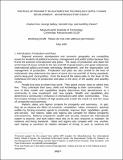The Role Of Proximity In Automotive Technology Supply Chain
Author(s)
Fine, Charles; Gilboy, George; Oye, Kenneth; Parker, Geoffrey
Downloadfine3.pdf (44.65Kb)
Metadata
Show full item recordAbstract
This essay is divided into the following sections: in section 1.1, we briefly
argue that the auto industry is a compelling case for studying regional economic
development and economic geography precisely because it generates large numbers
of high-quality jobs, and forges tight linkages to production and jobs in upstream
and downstream sectors. In section 2, we present the issues of production and place
more systematically. Having established the importance of the issue of production
and place in this introduction, we move on to frame the debate by defining two
types of “space” over which public and private authorities have jurisdiction, and
across which production and its attendant jobs are (re)located. We further define
four types of proximity: geographic, organizational, cultural, and electronic, that
plausibly contribute to the success of economic development. These kinds of
proximity offer varied incentives and disincentives for industrial agglomeration,
and therefore inspire competition between nations, states and regions for the
location of production and jobs. Also in section 2, we introduce two issues that
have remained largely unexplored in the literature on regional economic
development and economic geography: the strategic interaction between and among
firms and public authorities, and the question of production technology
development and sourcing.
Description
Working Draft, 1995
Date issued
2002-09-11Keywords
automotive technology supplier